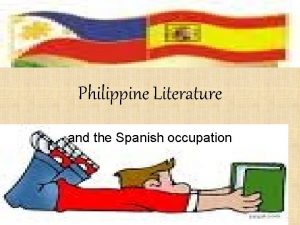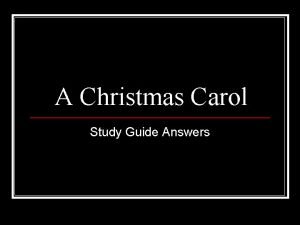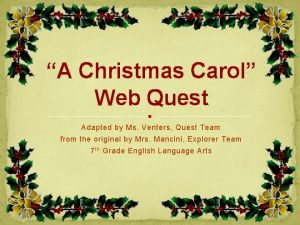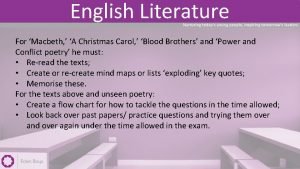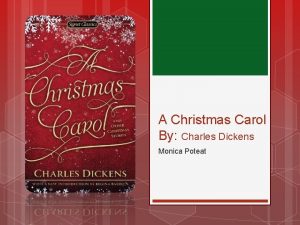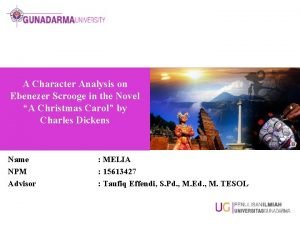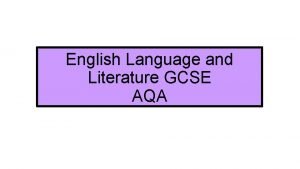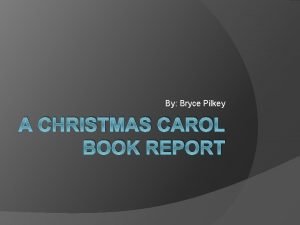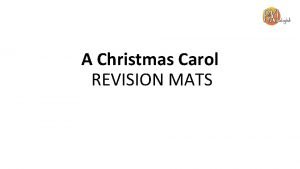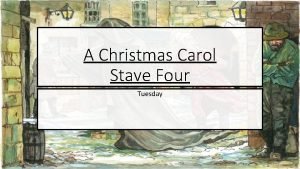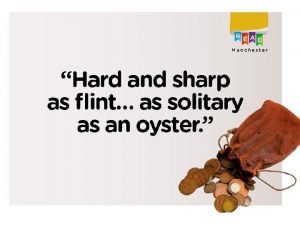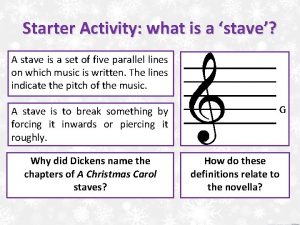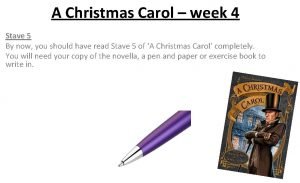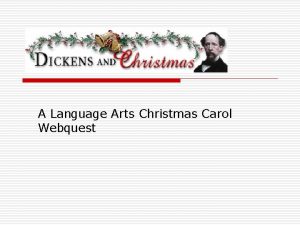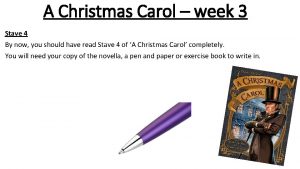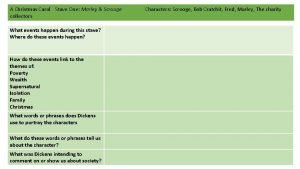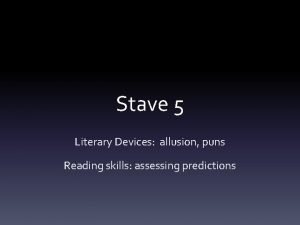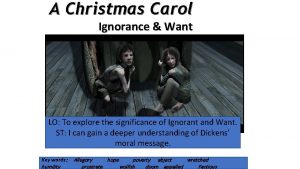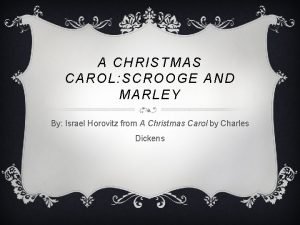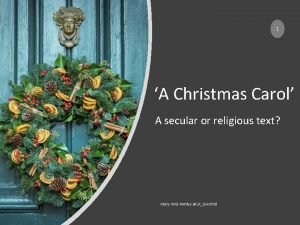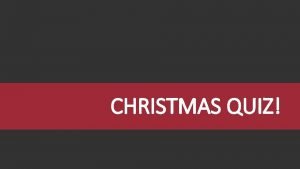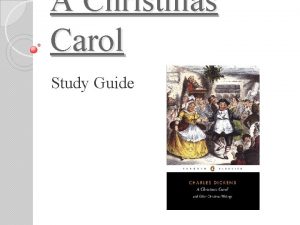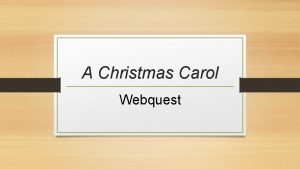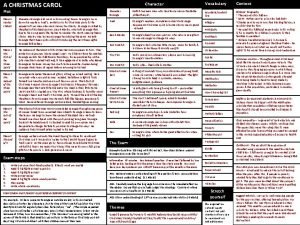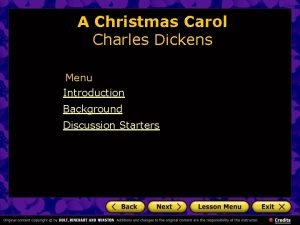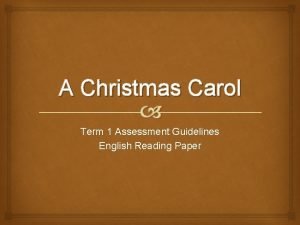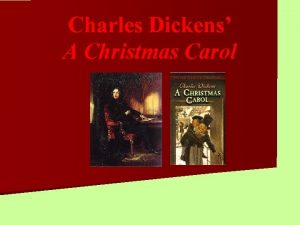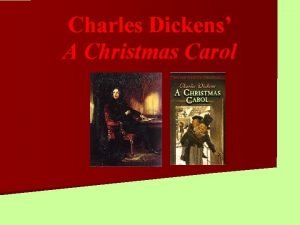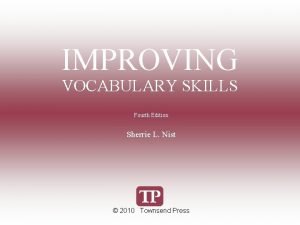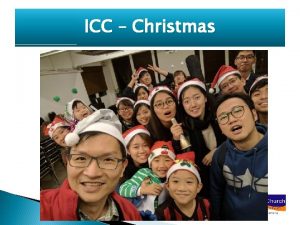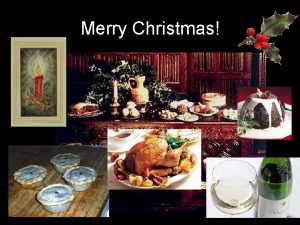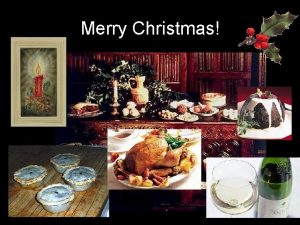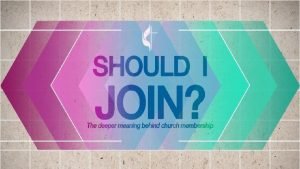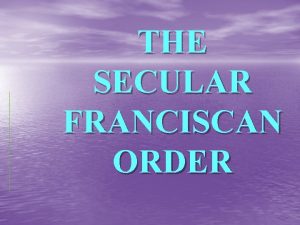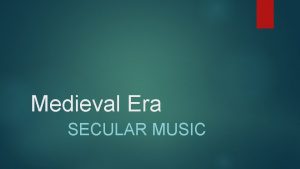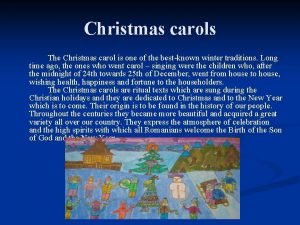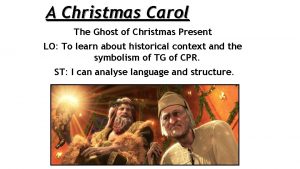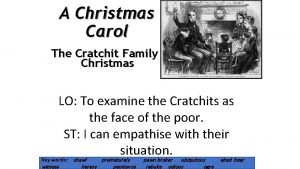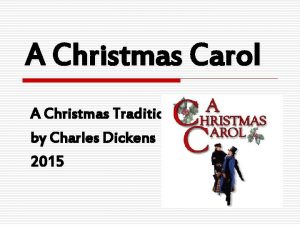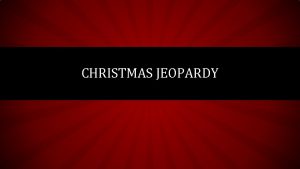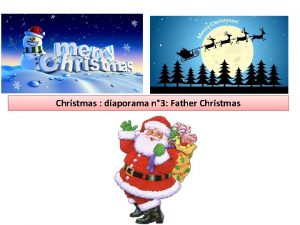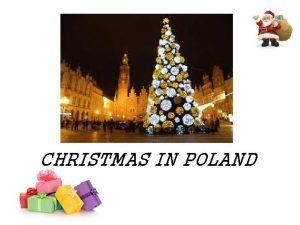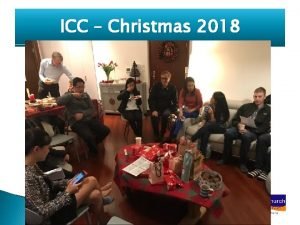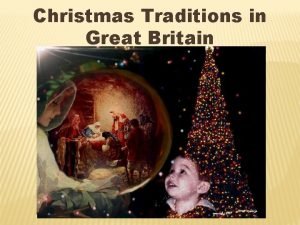1 A Christmas Carol A secular or religious


































- Slides: 34

1 ‘A Christmas Carol’ A secular or religious text? Mary Hind-Portley @Lit_Liverbird

‘A Christmas Carol’: a secular or religious text? • • Structure of the presentation: The text Biographical studies Critical viewpoints Questions for discussion Discussion Takeaways Mary Hind-Portley @Lit_Liverbird 2

The text: close reading • Before any teaching or background reading, deep familiarisation with the text is key. • Close reading and annotation are essential: I have two copies of the text: 1) my annotated teaching copy 2) a blank copy for annotating whilst teaching (modelling) • The EMC text is excellent for both teachers and students Mary Hind-Portley @Lit_Liverbird 3

The text: close reading From what perspective are we reading? How strong is our knowledge of the Christian tradition? Does this appear to be a Christian story? Evidence? Or is the text: A ghost story? A fable? A masque? A fairy tale? An allegory? A parable? A conversion story? Mary Hind-Portley @Lit_Liverbird 4

The text: Stave I ‘A Merry Christmas! God save you!’ cried a cheerful voice. … ‘Bah!’ said Scrooge, ‘Humbug!’ ‘apart from the veneration due to its sacred name and origin. . ’ ‘and I say, God bless it!’ ‘…Christian cheer’ ‘good Saint Dunstan…the Evil Spirit’s nose’ ‘Not to know that any Christian spirit working kindly in its little sphere… Why did I walk through crowds of fellow -beings with my eyes turned down, and never raise them to that blessed Star which led the Wise Men to a poor abode!’ Mary Hind-Portley @Lit_Liverbird 5

The text: Stave I Dickens presents Scrooge as without ‘Christian cheer’ in contrast to the warm, ruddy-faced Fred and to some extent the Charity gentlemen. Marley is the first to hold Scrooge to account for his selfish and un. Christian behaviour, announced by the door knocker and the fire place, the absence of bowels symbolizing his lack of compassion (Gospel of Matthew) That Christmas Eve Scrooge, alone in his cold empty house is destined to be haunted. First by his partner, Marley, doomed to wander forever as penance for his hard-heartedness. Sutherland (2014) Mary Hind-Portley @Lit_Liverbird 6

Stave II The Ghost of Christmas Past is presented as light and bright With ‘fresh green holly’ and ‘summer flowers’ ‘from the crown of its head there sprung a bright clear jet of light’ ‘Is it not enough that you are one of those who made this cap, and force me through whole trains of years to wear it low upon my brow!’ ‘. . but though Scrooge pressed it down with all his force, he could not hide the light, which streamed from under it, in an unbroken flood upon the ground. ’ The Victorian Christmas blends the pagan and Christian, just as the Christian faith borrowed the pagan festivals as part of the Church year; it brings the manor house to the city. (see Paul Davis) Misconception: that the Ghosts represent the Holy Trinity. Mary Hind-Portley @Lit_Liverbird 7

Stave III ‘… and on his head it wore no other covering than a holly wreath’ ‘You seek to close these places on the Seventh Day? . . . Forgive me if I am wrong. It has been done in your name, or at least in that of your family. ’ ‘and stopped to bless Bob Cratchit’s dwelling with a sprinkling of his torch. ’ ‘He told me… that he hoped the people saw him in church , because he was a cripple, and it might be pleasant to them to remember upon Christmas Day, who made lame beggars walk, and blind men see. ’ ‘God bless us everyone. ’ ‘and was overcome with penitence and grief’ Mary Hind-Portley @Lit_Liverbird 8

Stave III "Man, " said the Ghost, "if man you be in heart, not adamant, forbear that wicked cant until you have discovered What the surplus is, and Where it is. Will you decide what men shall live, what men shall die? It may be, that in the sight of Heaven, you are more worthless and less fit to live than millions like this poor man's child. Oh God! To hear the Insect on the leaf pronouncing on the too much life among his hungry brothers in the dust. " Scrooge bent before the Ghost's rebuke, and trembling cast his eyes upon the ground. ‘For it is good to be children sometimes, and never better than at Christmas, when its mighty Founder was a child himself. ’ Mary Hind-Portley @Lit_Liverbird 9

Stave IV Here we are presented with a soulless world, silently presented by the Ghost of Christmas Yet to Come. ‘It’s a judgement on him. ’ (Mrs Dilber) ‘My life tends that way now. Merciful Heaven, what is this? ’ ‘And He took a child and set him in the midst of them. ’ ‘Spirit of Tiny Tim, thy childish essence was from God! I will honour Christmas in my heart, and try to keep it all year… Holding up his hands in a last prayer to have his fate reversed, he saw an alteration in the Phantom’s hood and dress. It shrunk, collapsed, and dwindled down into a bedpost. Mary Hind-Portley @Lit_Liverbird 10

Stave V A reversal of Stave I ‘I am as a happy as an angel…’ ‘Heavenly sky. . ’ ‘And so as Tiny Time observed, God bless Us, Every One!. Mary Hind-Portley @Lit_Liverbird 11

Using CLi. C Dickens Mary Hind-Portley @Lit_Liverbird 12

In search of Dickens’ Christian beliefs. Mary Hind-Portley @Lit_Liverbird 13

Biographical studies: Peter Ackroyd states: He also began work on what he called ‘The Life of Our Lord, a hand-written manuscript which was not completed for three years, in which he recounts the story of the New Testament (largely drawn upon the gospel according to Luke) in the simple language of a children’s tale or a fairy story, the latter influence perhaps suggesting the extent to which Dickens turned all of the most significant aspects of his life into just such a story…. It can be fairly said that the New Testament was at the core of Dickens’s own religion. Mary Hind-Portley @Lit_Liverbird 14

Biographical studies: Peter Ackroyd “I hold our Saviour to the model of all goodness, and I assume that, in a Christian Country where the New Testament is accessible to all, all goodness must be referred back to its influence. ” He told his younger son that the New Testament was “… the best book that ever was or ever will be known in the world… and I now most solemnly impress upon you the truth and beauty of the Christian religion, as it came from Christ himself…’ Mary Hind-Portley @Lit_Liverbird 15

Biographical studies: Peter Ackroyd Of course his life and opinions are one thing, his art another. It is quite interesting to note that in his actual novels no character seems ever to be primarily impelled by Christian motives, and churches themselves tend to be portrayed as dusty places of empty forms and rituals…. Mary Hind-Portley @Lit_Liverbird 16

Biographical studies: Peter Ackroyd …this disparity between his vigorous public expression of Christian sentiment and his almost total lack of interest in Christian institutions or Christian representatives is close to the essence of the matter: he was a man of religious sensibility but his beliefs were determined by his own vision of the world rather than by any inherited or specific creed. That is why the Christian faith becomes, for him a larger and brighter version of the sentiments he promulgated in his Christmas books, at no point does it seem that Dickens relied upon any religious ‘authority’ other than his own will and temperament. In last resort, he believed no one other than himself. Mary Hind-Portley @Lit_Liverbird 17

Biographical studies: Claire Tomalin Dickens responded to Niagara with intense emotion was moved to religious utterance , ‘It would be hard for a man to stand nearer to God than he does there. ’ Dickens disliked and mocked displays or piety, but he maintained a reverential attitude towards the idea of God throughout his life Mary Hind-Portley @Lit_Liverbird 18

Biographical studies: Claire Tomalin The book went straight to the heart of the public and it has remained lodged there ever since, with its mixture of horror, despair, hope and warmth – a Christian message – even the worst of sinners may repent and become a good man… Mary Hind-Portley @Lit_Liverbird 19

Blog Christmas and Christianity in the novella “One area of reflection has been on the Christian theology which pervades the novella with the second most significant Christian event in its title, (Easter being the most significant). Stave 3 presents images of Christmas modern readers may see as traditional. Peter Ackroyd comments, ‘Dickens can be said to have almost single-handedly created the modern Christmas’ but Ackroyd also challenges his own view that Dickens invented Christmas ‘as the more sentimental of his chroniclers have suggested. ’ Ackroyd gives a useful insight into the development of the Victorian Christmas, ‘What Dickens did was to transform the holiday by suffusing it with his own particular mixture of aspirations, memories and fears. He invested it with fantasy and with a curious blend of religious mysticism and popular superstition… In addition, he made it cosy, he made it comfortable and he achieved this by exaggerating the darkness beyond the small circle of light. ’ (pp 203 -231). ” Mary Hind-Portley @Lit_Liverbird 20

Blog Christianity How can different Christian theologies be used to read the text? Although I am a practising Christian, I am not a theologian but I am intrigued about Dickens’ own theological framework. As ACC is embedded in many people’s cultural schema, it can be easy to see the novel as a straightforward tale of redemption and transformation with a generic Christian theology, ‘Dickens’ modern fairytale of Scrooge and the Cratchits with its strong, but wholly non-sectarian Christian colouring had an impact no lead-writer or moralising satirical journalist… could have hoped to achieve’ However, in discussion with Matt Lynch (@Mathew _Lynch 44) about Christianity in the novella, it is too simplistic to consider it to be non-sectarian. Matt spoke about the influence of Unitarian beliefs on Dickens making me consider my own understanding of Scrooge’s spiritual journey in the context of different branches of Christian beliefs. I have been teaching my students about Scrooge’s transformational journey of redemption. However, the Victorian Unitarian belief in salvation is an area to consider when exploring Scrooge’s changed nature at the end of the novella. How far Dickens consciously framed the novel with specific Christian theologies may not be clear and merits further research. In terms of student understanding, I have previously explored the concepts of transformation and redemption, through the narrative arc of the ghosts and Scrooge’s journey through time and space. Therefore, clarifying the definitions and exploring the difference between redemption and salvation has been interesting prior to teaching ACC in half-term 2 Mary Hind-Portley @Lit_Liverbird 21

Blog redemption: the undoing of the effects of sin for all mankind. Perform an act to get something in return, ie if one commits a sin, one does something to buy back sinlessness (paying a forfeit). This internal change is then externalised by actions. salvation: being saved from the consequences of sin, brought about by faith in Christ saves us by becoming the mechanism for our redemption. This is external. Salvation is the second part of the redemption story Mary Hind-Portley @Lit_Liverbird 22

Blog Holman Hunt’s painting The Light of the World’ (1851 -3) assists us with this understanding, The door in the painting has no handle, and can therefore be opened only from the inside, representing "the obstinately shut mind" (1905). Scrooge must open his oyster-like mind, redeem himself through atoning for his sins, ‘Oh, tell me I may sponge away the writing on this stone. ’ He has to purchase the turkey for the Cratchits, donate to charity, visit Fred and raise Bob’s salary to be absolved of his sins. The process of Scrooge’s transformation is central to the novella, Scrooge must be redeemed in order to be saved. Michael Timko in his article ‘No Scrooge He: The Christianity of Charles Dickens’ discusses Dickens’ Christianity and the centrality of his faith to his writing, ‘He wanted his novels to be “parables, ” stories that would emphasize the teachings of Christ. ’ In ACC we see Dickens’ faith through Scrooge’s journey from miser to benefactor, to redemption and then to salvation. His chief aim, as I noted at the beginning, was to promote individual “salvation” and bring about social reform. His “religious” views, while perhaps not strictly sectarian, were meant not so much to undermine orthodox belief as to demonstrate that a “practical” and humanitarian Christianity that reflected the life of Christ could solve personal and social problems. Mary Hind-Portley @Lit_Liverbird 23

Critical viewpoints: Paul B Davis ‘The Victorian Carol connected the city to the traditions of the country. It also revealed a new urban world infused with spirit (s), and so it became a kind of scripture. As Darwinism and doubt undermined the authority of the Bible, secular texts assumed Biblical authority. Although we now see the Carol as a secular book, Victorians of the 1870 s, the decade following Dickens’ death reading his Christmas story as a retelling of the biblical Christmas story. Mary Hind-Portley @Lit_Liverbird 24

Critical viewpoints: Paul B Davis ‘… the Carol like many novels of the period as Barry Qualls has shown, is deeply rooted in Bunyan and the Bible… Though Ruskin and others could not see through the ‘naturalism’ of the Carol to its supernatural level, many more Victorians were moved by its spiritual power. ’ Davis discusses the typological structure of the story, ‘a division of Old and New Testament worlds, into type and antitype…Jacob Marley, Ebenezer Scrooge inhabits an Old Testament consciousness (p 79)…In the Cratchit home, the names – Peter, Martha, Timothy – tend to be drawn from the New Testament. ’ Mary Hind-Portley @Lit_Liverbird 25

Critical viewpoints: Paul B Davis In the chapter, ‘Founder of the Feast’, Davis presents a detailed commentary on the biblical allusions made by Dickens. ‘Theologically, A Christmas Carol is an early version of what came to be known later in the century as ‘the social gospel’ (p 81). . The experience of conversion revealed itself in commitment to this earthly kingdom and in the performance of good works. This doctrine, particularly prevalent in the United States from about 1880 on, had its roots in Evangelical social concern, in the social theology of F D Maurice developed during the thirties and forties, and in Unitarianism , with which Dickens was involved in in the 1840 s. ’ Did these influence Dickens? Mary Hind-Portley @Lit_Liverbird 26

Critical viewpoints: Paul B Davis As ‘social gospel’ A Christmas Carol is the story of the Cratchit family. In evolutionary terms they represent a stage in human development beyond Scrooge…’ Davis points out that the Cratchit Christmas dinner is ‘emblematic of the Christian tradition of agape. ’ Scrooge is guided by the ‘the gospel of getting on’ (Ruskin) ‘The conversion experience of the Carol could not be Scrooge’s alone. Becoming like Bob a father to Tiny Tim, needed to be the collective experience of all who read or heard the message of this social gospel. Mary Hind-Portley @Lit_Liverbird 27

Critical viewpoints: Joshua Taft “And one of the best portraits of religion in modernity can be found not in social theory but in fiction: Charles Dickens’s A Christmas Carol(1843) shows how these religious positions coexist, reminding us how each could appear compelling in turn. As readers have long recognized, Dickens offers a disenchanted and humanistic Christianity, one that preserves a vague belief in the supernatural but stresses humanistic ethics. In this way, A Christmas Carol echoes the views of its creator, a believer in a largely rationalized, deliberately vague Christianity. ” Mary Hind-Portley @Lit_Liverbird 28

Critical viewpoints: Joshua Taft Thus, while vestiges of disenchanted Christianity appear in A Christmas Carol, the text also offers a perspective that secularization theory ignores: a non-religious account of Christmas set within a deeply enchanted world. This seemingly contradictory perspective emerges through a literary division of labor. Thematically, A Christmas Carol explores disenchanted religion, offering a minimally Christian parable (what might be called An Ecumenical Non-Sectarian Interfaith Carol). But on the level of form, Dickens uses a mixture of genres – the ghost story and masque – and deliberate descriptive excess topresent a world full of wholly secular wonders. Hence A Christmas Carol emerges as a surprisingly perceptive analysis of religion and secularism. It anticipates the central insights of secularization theory – the connections between faith, skepticism, and enchantment –while presenting religious possibilities that scholarship has only now begun to explore. Mary Hind-Portley @Lit_Liverbird 29

Critical viewpoints: Joshua Taft But Dickens was not a skeptic; as Valentine Cunningham argues, Dickens was a man whose writing was “steeped. . . in the knowledge, the words, the stories, the rhetoric, the practices” (255) of the Church of England. When he directly addresses religious faith, he offers a variant of Christianity that preserves a minimal theological content while stressing its ethical components. His rewriting of the Gospels for his children (posthumously published as The Life of Our Lord) exhibits these two qualities that best characterize Dickens’s faith: an emphasis on moral behavior and a strong aversion to any particular theological dogma (without making any concerted effort to deny the supernatural). He ends the work by offering a concentrated version of Christianity, declaring that the essence of the religion is “TO DO GOOD always. . . to love our neighbour as ourself. . . to be gentle, merciful, and forgiving” Mary Hind-Portley @Lit_Liverbird 30

Critical viewpoints: Joshua Taft Why was a religious writer viewed, then as now, as the proponent of a secularized version of Christianity? Because the explicit religious content of A Christmas Carol occupies a position at the fringes of disenchanted faith, as close to secularism as possible. Its narrative never overtly rejects Christianity; typically, it pays a brief tribute to religious belief and then quickly diverts its attention to the secular world. Jacob Marley’s prophetic warning, for instance, humanizes the Christian language of sin and punishment. Marley’s fate derives from his neglect of a basic duty that all must follow: to “walk abroad among his fellow-men” (22; stave I), either in life or after death. Having disregarded this obligation, he warns Scrooge, he wears the chains he “forged in life” (22; stave I). Yet this passage is notable not just for Dickens’s transformation of a familiar Christian topos – punishment after death for a sinful life – but also for its deeply humanistic version of “sin. ” When Scrooge praises Marley’s abilities as a businessman, Marley famously responds with the declaration “mankind was my business” (23; stave I). His fault was not neglecting religious faith but disregarding his obligations to other human beings. Mary Hind-Portley @Lit_Liverbird 31

Critical viewpoints: Joshua Taft When Scrooge asks about the closing of bakeries on a Sunday in Stave III (Sabbatarianism) ‘. . this can be seen as the counterpart to the humane Social Gospel of Dickens’s religion. If the heart of Christian belief, for Dickens, lies in treating one’s neighbor with compassion and kindness, than a Christianity that impoverishes people’s lives for ostensibly pious reasons would be a horrific distortion of true religion. Dickens’s Broad. Church Christianity, then, takes two forms in its brief appearances here. It praises religion at its non-dogmatic best, promoting a “simple, New Testament Christianity” characterized by “the power of kindness and benevolence” (Ledger 123); and it attacks stringent forms of religion that interfere with human flourishing. ’ Mary Hind-Portley @Lit_Liverbird 32

Critical viewpoints: Joshua Taft When the text does mention religious belief, it largely coincides with Dickens’s own brand of cheerfully undogmatic Christianity. One of the two most extensive discussions of Christian faith – a paragraph of dialogue from Bob Cratchit, telling his wife about his trip to church with Tiny Tim – makes this pattern clear. Cratchit praises his son’s behavior at church, admiring his display of humility and piety. The incident lingering in his mind, we are told, is when Tiny Tim tells his father that “he hoped the people saw him in the church, because he was a cripple, and it might be pleasant to them to remember upon Christmas Day, who made lame beggars walk, and blind men see” (50; stave III). This brief line of dialogue holds true to Dickens’s vague statements about Christianity. It is, on the one hand, undeniably Christian; the miracles Tiny Tim mentions are assumed to be genuine signs of divine power. And yet this statement leads to no real insights about religious belief or dogma. It treats Christianity favorably, but has nothing more to say about the supernatural content it mentions. This brief conversation between the Cratchits sets the tone for almost every discussion of faith in A Christmas Carol: as with Tiny Tim’s pious reflections in church, the text approves of Christianity but is almost completely uninterested in the details of religious practice. Mary Hind-Portley @Lit_Liverbird 33

Bibliography 34 • Ackroyd, Peter (1994) Dickens abridged edition; Vintage Books, London • CLi. C Dickens clic. bham. ac. uk. • Davis, Paul B (1990) The Lives and Times of Ebenezer Scrooge Yale University Press; New Have and London • Faber, Michael (2005) https: //www. theguardian. com/books/2005/dec/24/featuresreviews. guardianreview 22 • Mahlberg, M. , Stockwell, P. , de Joode, J. , Smith, C. , & O’Donnell, M. B. (2016). CLi. C Dickens: Novel uses of concordances for the integration of corpus stylistics and cognitive poetics. Corpora, 11(3), 433– 463. Mary Hind-Portley @Lit_Liverbird • Timko, Michael ‘No Scrooge he’ • https: //www. americamagazine. org/issue/681/bookings/no-scrooge-he • Tomalin, Claire (2012) Dickens A Life Penguin Books, London • Taft, Joshua (2015) Disenchanted religion and secular enchantment in A Christmas Carol ; Victorian Literature and Culture (2015), 43, 659– 673. © Cambridge University Press 2015. 1060 -1503/15 doi: 10. 1017/S 10601503150001
 Karagatan theater
Karagatan theater Christmas bells ringing through the land
Christmas bells ringing through the land Study guide a christmas carol
Study guide a christmas carol A christmas carol webquest
A christmas carol webquest Macbeth and a christmas carol past papers
Macbeth and a christmas carol past papers A christmas carol antagonist
A christmas carol antagonist Character traits for ebenezer scrooge
Character traits for ebenezer scrooge Aqa english literature paper 1 2019 a christmas carol
Aqa english literature paper 1 2019 a christmas carol Direct characterization in a christmas carol
Direct characterization in a christmas carol Christmas carol book report
Christmas carol book report What is a christmas carol book about
What is a christmas carol book about Themes of a christmas carol
Themes of a christmas carol Christmas carol stave 4 summary
Christmas carol stave 4 summary Similes in a christmas carol
Similes in a christmas carol What is a stave
What is a stave Stave 5 a christmas carol
Stave 5 a christmas carol Christmas webquest
Christmas webquest Oh tell me i may sponge away the writing on this stone
Oh tell me i may sponge away the writing on this stone Christmas carol stave 1 summary
Christmas carol stave 1 summary Scrooge allusion examples
Scrooge allusion examples A christmas carol ignorance and want
A christmas carol ignorance and want Christmas carol israel
Christmas carol israel Religion in a christmas carol
Religion in a christmas carol Bible christmas quiz
Bible christmas quiz The santa clause christmas bells carol
The santa clause christmas bells carol A christmas carol study guide
A christmas carol study guide A christmas carol webquest
A christmas carol webquest A christmas carol summary stave 1
A christmas carol summary stave 1 Stuart pryke dropbox a christmas carol
Stuart pryke dropbox a christmas carol Christmas carol background
Christmas carol background A christmas carol introduction lesson
A christmas carol introduction lesson Main character in christmas carol
Main character in christmas carol Verbal irony in a christmas carol
Verbal irony in a christmas carol What is the climax of a christmas carol
What is the climax of a christmas carol What does secular mean
What does secular mean
